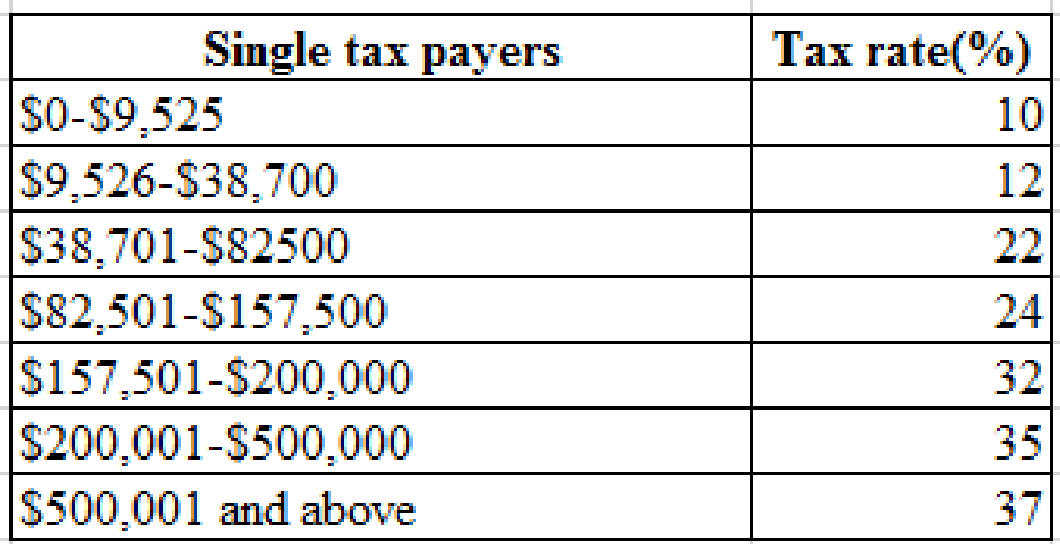
a)
To determine: Average tax rate and marginal tax rate of a single tax payer.
a)
Explanation of Solution
Given information:
The income of the single tax payer is $20,000.
The slab rates of single tax payers are as follows, they are

If the taxable income is $20,000 then up to $9,525 the tax rate is 10% and after that remaining balance is charged under 12% tax rate.
Calculation of taxes:
Hence, taxes are $2,209.50
Calculation of Average tax rate:
Hence, average tax rate is 11.05%
The marginal rate of tax is the tax rate that a person is incurred on his income of each additional dollar. Here the marginal rate is 12% incurred on each additional dollar of his income.
b)
To determine: Average tax rate and marginal tax rate of a single tax payer.
b)
Explanation of Solution
Given information:
The income of the single tax payer is $50,000.
If the taxable income is $50,000 then up to $9,525 the tax rate is 10%, after that tax rate is 12% up to $38,700 then, after remaining balance is charged under 22% tax rate.
Calculation of taxes:
Hence, taxes are $6,939.50
Calculation of Average tax rate:
Hence, average tax rate is 13.88%
The marginal rate of tax is the tax rate that a person is incurred on his income of each additional dollar. Here the marginal rate is 22% incurred on each additional dollar of his income.
c)
To determine: Average tax rate and marginal tax rate of a single tax payer.
c)
Explanation of Solution
Given information:
The income of the single tax payer is $300,000.
If the taxable income is $300,000 then up to $9,525 the tax rate is 10%, after that tax rate is 12% up to $38,700, up to $82,500 the tax rate is 22% and up to $157,500 the tax rate is 24% and up to $200,000 the tax rate is 32%, then the remaining balance is charged under 35% tax rate.
Calculation of taxes:
Hence, taxes are $78,445.50
Calculation of Average tax rate:
Hence, average tax rate is 26.14%
The marginal rate of tax is the tax rate that a person is incurred on his income of each additional dollar. Here the marginal rate is 35% incurred on each additional dollar of his income.
d)
To determine: Average tax rate and marginal tax rate of a single tax payer.
d)
Explanation of Solution
Given information:
The income of the single tax payer is $3,000,000.
If the taxable income is $3,000,000 then up to $9,525 the tax rate is 10%, after that tax rate is 12% up to $38,700, up to $82,500 the tax rate is 22% and up to $157,500 the tax rate is 24% and up to $200,000 the tax rate is 32%, and up to $500,000 the tax rate is 35% then the remaining balance is charged under 37% tax rate.
Calculation of taxes:
Hence, taxes are $1,075,689.50
Calculation of Average tax rate:
Hence, average tax rate is 35.86%
The marginal rate of tax is the tax rate that a person is incurred on his income of each additional dollar. Here the marginal rate is 37% incurred on each additional dollar of his income.
Want to see more full solutions like this?
Chapter 3 Solutions
FUNDAMENTALS OF CORP.FIN.(LL)-W/CONNECT
- Terrier Company is in a 45 percent tax bracket and has a bond outstanding that yields 11 percent to maturity. a. What is Terrier's after-tax cost of debt? b. Assume that the yield on the bond goes down by 1 percentage point, and due to tax reform, the corporate tax falls to 30 percent. What is Terrier's new aftertax cost of debt? c. Has the after-tax cost of debt gone up or down from part a to part b? Explain why.arrow_forwardThe Squeaks Cat Rescue, which is tax-exempt, issued debt last year at 9 percent to help finance a new animal shelter in Rocklin. a. If the rescue borrowed money this year, what would the after-tax cost of debt be, based on its cost last year and the 25 percent increase? b. If the receipts of the rescue were found to be taxable by the IRS (at a rate of 25 percent because of involvement in political activities), what would the after-tax cost of debt be?arrow_forwardNo chatgptPlease don't answer i will give unhelpful all expert giving wrong answer he is giving answer with using incorrect values.arrow_forward
- Please don't answer i will give unhelpful all expert giving wrong answer he is giving answer with incorrect data.arrow_forward4. On August 20, Mr. and Mrs. Cleaver decided to buy a property from Mr. and Mrs. Ward for $105,000. On August 30, Mr. and Mrs. Cleaver obtained a loan commitment from OKAY National Bank for an $84,000 conventional loan at 5 percent for 30 years. The lender informs Mr. and Mrs. Cleaver that a $2,100 loan origination fee will be required to obtain the loan. The loan closing is to take place September 22. In addition, escrow accounts will be required for all prorated property taxes and hazard insurance; however, no mortgage insurance is necessary. The buyer will also pay a full year's premium for hazard insurance to Rock of Gibraltar Insurance Company. A breakdown of expected settlement costs, provided by OKAY National Bank when Mr. and Mrs. Cleaver inspect the uniform settlement statement as required under RESPA on September 21, is as follows: I. Transactions between buyer-borrower and third parties: a. Recording fees--mortgage b. Real estate transfer tax c. Recording fees/document…arrow_forwardHello tutor give correct answerarrow_forward
- Could you help explain, what is the complete salary survey analysis, and ensuring the data is relevant and up-to-date? What is the job evaluation and compensation plan? How to ensure the final report is comprehensive, clearly structured, and aligned with the company vision?arrow_forwardThe maturity value of an $35,000 non-interest-bearing, simple discount 4%, 120-day note is:arrow_forwardCarl Sonntag wanted to compare what proceeds he would receive with a simple interest note versus a simple discount note. Both had the same terms: $18,905 at 10% for 4 years. Use ordinary interest as needed. Calculate the simple interest note proceeds. Calculate the simple discount note proceeds.arrow_forward
 Essentials Of InvestmentsFinanceISBN:9781260013924Author:Bodie, Zvi, Kane, Alex, MARCUS, Alan J.Publisher:Mcgraw-hill Education,
Essentials Of InvestmentsFinanceISBN:9781260013924Author:Bodie, Zvi, Kane, Alex, MARCUS, Alan J.Publisher:Mcgraw-hill Education,

 Foundations Of FinanceFinanceISBN:9780134897264Author:KEOWN, Arthur J., Martin, John D., PETTY, J. WilliamPublisher:Pearson,
Foundations Of FinanceFinanceISBN:9780134897264Author:KEOWN, Arthur J., Martin, John D., PETTY, J. WilliamPublisher:Pearson, Fundamentals of Financial Management (MindTap Cou...FinanceISBN:9781337395250Author:Eugene F. Brigham, Joel F. HoustonPublisher:Cengage Learning
Fundamentals of Financial Management (MindTap Cou...FinanceISBN:9781337395250Author:Eugene F. Brigham, Joel F. HoustonPublisher:Cengage Learning Corporate Finance (The Mcgraw-hill/Irwin Series i...FinanceISBN:9780077861759Author:Stephen A. Ross Franco Modigliani Professor of Financial Economics Professor, Randolph W Westerfield Robert R. Dockson Deans Chair in Bus. Admin., Jeffrey Jaffe, Bradford D Jordan ProfessorPublisher:McGraw-Hill Education
Corporate Finance (The Mcgraw-hill/Irwin Series i...FinanceISBN:9780077861759Author:Stephen A. Ross Franco Modigliani Professor of Financial Economics Professor, Randolph W Westerfield Robert R. Dockson Deans Chair in Bus. Admin., Jeffrey Jaffe, Bradford D Jordan ProfessorPublisher:McGraw-Hill Education





